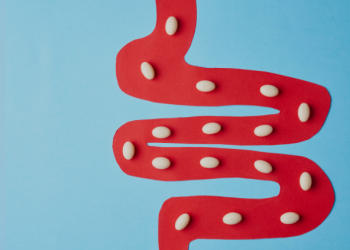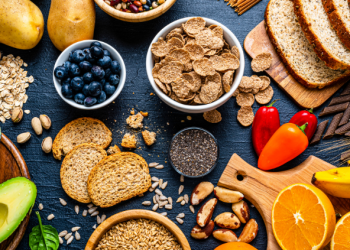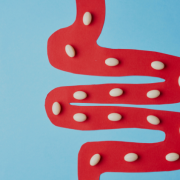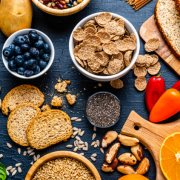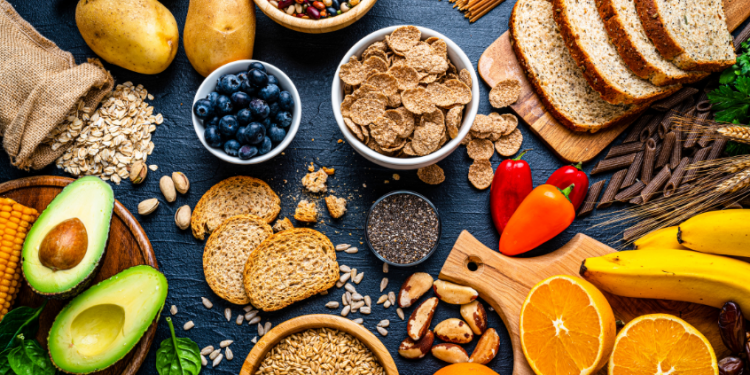By Maya Shetty, BS

This blog is part of our Supplements newsletter. If you like this content, sign up to receive our monthly newsletter!
Key Takeaways:
- Vitamin D affects the health of bones and also plays a role in our muscles, immunity, and prevention of some diseases.
- The most common form of vitamin D is synthesized in the skin after exposure to sunshine. Vitamin D can also be found in some foods naturally as well as supplements and fortified foods.
- Vitamin D insufficiency is defined as less than 30 ng per mL of blood. Strive to maintain sufficient vitamin D levels through a balanced diet, sensible sun exposure, and supplementation as needed.
- When choosing a vitamin D supplement, D3 is recommended over D2, and should be combined with a fat (such as a handful of almonds or an Omega-3 supplement). You should not take more than 4,000 IU (100 mcg) per day due to the potential for toxicity unless recommended by a medical professional.
In a nation saturated with supplements, vitamin D commands the spotlight as one of the most widely taken across all age groups, second only to multivitamins.
“Ever since vitamin D deficiency was found to be the root cause of rickets, we have long recognized its role in bone health. Now research is looking at this vitamin as a panacea for numerous ailments, from the common cold, to even cancer,” states Robert Oh, MD, MPH, Chief Wellness Officer of the VA Palo Alto Healthcare System.
As ongoing research peels back the layers of complexity surrounding this vitamin, the scientific landscape becomes dynamic and subject to rigorous debate.
Where Does Vitamin D Come From?
Vitamin D distinguishes itself from other vitamins due to its unique ability to exist as both a dietary nutrient and as a hormone. Sourced from sunlight exposure, food, and supplements, this fat-soluble vitamin accumulates in the body’s fatty tissues and liver, available to be released as needed.
Sunlight
The primary source of vitamin D is the production that occurs in our skin from cholesterol precursors when exposed to the sun’s ultraviolet-B (UVB) rays, earning its nickname “the sunshine vitamin.” Considering the pivotal role sunlight plays in vitamin D production, daily exposure is beneficial.
Some plants and animals also possess the ability to synthesize vitamin D, contributing to the vitamin’s content in various foods and supplements. In plants, vitamin D is in the form D2 (ergocalciferol), while in animals, including humans, it is in the form D3 (cholecalciferol). Both forms are absorbable by humans; however, there is evidence suggesting that D3 has a more substantial and prolonged impact.
Food
High amounts of vitamin D3 are found in oily fishes such as salmon, mackerel, and sardines, whereas small amounts are found in eggs, red meat, and liver.
Vitamin D2 is found in specific mushrooms, but its concentrations vary significantly based on exposure to light. Mushrooms, much like our skin, require sunlight for vitamin D production. “Since commercially available mushrooms are typically grown in dark conditions, they contain minimal amounts of vitamin D and organic mushrooms will contain almost none. Exposure to UV light through irradiation, which is not allowed in organic food production, will substantially increase conventional mushroom vitamin D content,” said Rachele Pojednic, PhD, Stanford University nutrition and exercise scientist.
Due to the limited natural food sources of vitamin D, many products, including breakfast cereals, dairy items, and plant-based milks, are fortified with vitamin D2 and D3. For a comprehensive list of vitamin D content in specific foods, refer to the U.S. Department of Agriculture (USDA) list categorized by nutrient content and food name.
Supplements
Vitamin D2 and D3 can be found in supplement form. Due to the potentially higher bioavailability, D3 supplements are typically recommended over D2.
Dr. Pojednic emphasizes the importance of considering the fat-soluble nature of vitamin D when taking a supplement. “Vitamin D absorption, especially when consumed in concentrated doses, will be significantly enhanced when taken in conjunction with dietary fat, such as a handful of almonds or an omega-3 supplement,” she says.
When determining the appropriate vitamin D supplementation dosage, keep in mind that higher is not better. Toxic levels of vitamin D can arise from excessive supplement intake, a risk not associated with sunlight exposure due to the skin’s ability to self-regulate production. Therefore, Dr. Oh advises consulting with a physician or dietitian before taking high-dosage supplements. “Too much vitamin D can cause health issues, such as too high calcium levels or even kidney damage, so work with your care team if you are taking high doses of vitamin D,” he says.
Health Benefits of Vitamin D
Vitamin D is crucial for human health. While primarily recognized for its role in building strong bones, new findings suggest that this fat-soluble vitamin may exert a broader influence throughout the body.
“We now know that the majority of organs and tissues in the body possess vitamin D receptors,” states Dr. Pojednic. “This finding suggests vitamin D has effects beyond the skeletal system, sparking considerable research in the potential benefits of vitamin D for multiple health conditions.”
A substantial portion of this research focuses on the effects of vitamin D supplements, rather than dietary and sunlight sources. However, this by no way means the benefits of vitamin D are found solely through supplementation. Additionally, it should be noted that many studies have not compared outcomes in individuals with sufficient versus deficient vitamin D blood levels, which make conclusions from many supplementation studies difficult to interpret.
Bone Health
Vitamin D stands as a key player in sustaining the structural integrity of our skeletal system by facilitating the absorption of calcium and phosphorus—the building blocks of our bones. Through the process of mineralization, these minerals are incorporated into our bones to maintain normal bone density. Inadequate vitamin D levels can result in insufficient mineralization, which can lead to weakened bones and conditions such as osteoporosis, as well as more severe disorders like rickets and osteomalacia.
While the adverse effects of inadequate vitamin D on bone health are well-established, the evidence concerning the impacts of supplemental vitamin D over-and-above sufficient levels remains inconsistent.
In 2007, the US Agency for Healthcare Research and Quality synthesized the research on vitamin D and determined daily supplementation of vitamin D (≤ 800 IU) with calcium (≥ 500 mg) resulted in small increases in bone mineral density in older adults.
There is additional evidence that suggests that vitamin D supplementation lowers the risk of fractures in institutionalized older adults (700-800 IU vitamin D) and female navy recruits (800 IU vitamin D and 2000 mg calcium). However, both groups were initially at a high risk of vitamin D deficiency, and their levels were likely insufficient to begin with.
On the contrary, the largest vitamin D study to date, Vitamin D and Omega-3 Trial (VITAL), showed that daily supplementation of 2000 IU vitamin D did not reduce fracture risk in more than twenty-five thousand midlife and older adults who had sufficient vitamin D levels on average.
The current body of evidence indicates that vitamin D supplementation offers the most significant benefits for individuals with deficiencies. However, for those already meeting their vitamin D requirements, the benefits of additional supplementation are less clear. This suggests the need to approach vitamin D supplementation for bone health as a targeted strategy—aimed at maintaining sufficient levels rather than striving for excessively high, or supramaximal, levels. Such a focused approach ensures supplementation benefits those who need it, without unnecessary excess in those already meeting their vitamin D requirements.
Dr. Pojednic underscores the importance of a proactive approach, stating, “Ensuring sufficient intake of vitamin D and calcium serves as a foundational preventive measure to mitigate bone mineral loss and reduce the risk of osteoporosis later in life.” This strategy is particularly crucial early in life, as the foundation for peak bone mass, particularly for women, is established in our twenties. By achieving and maintaining optimal levels of vitamin D and calcium from a young age, individuals can maximize their bone strength and preserve it as they age.
Muscle Health
Our muscles need vitamin D to function and develop properly. Studies have established a correlation between deficient vitamin D levels and muscle weakness, pain, and atrophy. While the precise molecular mechanisms of vitamin D’s influence on skeletal muscle necessitate further investigation, cell culture studies indicate that vitamin D administration can alter cell pathways related to muscle contraction, cell proliferation, differentiation, growth, and inflammation.
An increasing body of research suggests a positive impact of high and low vitamin D supplementation on physical performance and injury prevention, particularly in vitamin D deficient adults and athletes. Research has identified a negative correlation between blood levels of vitamin D and biomarkers of muscle damage and inflammation, as well as number of injuries.
“These findings indicate the potential of vitamin D as a supplement for aiding recovery in injured or overtrained athletes,” states Dr. Pojednic. “However, further research is required to determine the optimal dosages and interventions for effective recovery.”
It has also been hypothesized that vitamin D may reduce the risk of falls in older adults by enhancing muscle strength and coordination, thus improving balance and postural sway. An analysis of multiple studies indicates that daily vitamin D supplementation may decrease the risk of falls in older adults with low vitamin D levels. However, this protective effect was not observed in individuals with sufficient vitamin D levels, a conclusion supported by the VITAL trial, which administered 2,000 IU of vitamin D daily.
The current evidence regarding vitamin D and muscle health suggests that the benefits of supplemental vitamin D are, again, primarily observed in individuals deficient in the vitamin, mirroring patterns observed in bone health. However, it may also have some benefit for athletes and others struggling with muscle damage and recovery. Overall, more research is needed to understand the optimal level of vitamin D for muscle health and determine whether these levels exceed what is required for bone health.
Immune Function
Vitamin D plays a crucial role in immune health, demonstrating various effects on inflammation, autoimmune diseases, and infection rates. The VITAL study revealed that healthy individuals taking vitamin D (2,000 IU per day) were less likely to develop autoimmune diseases such as rheumatoid arthritis and psoriasis, with a 22 percent reduction in incidence over the five-year supplementation period. However, these protective effects were no longer evident after participants discontinued the vitamin D supplement. This implies that vitamin D needs to be consistently taken for long-term prevention.
In the context of respiratory health, a comprehensive meta-analysis demonstrated that daily or weekly vitamin D supplementation lowers the risk of upper respiratory tract infections, especially in very deficient individuals. During the COVID-19 pandemic, studies revealed that low serum levels are associated with a higher risk of COVID-19 infection.
These findings underscore the importance of maintaining optimal vitamin D levels for immune health and the long-term prevention of autoimmune and respiratory diseases. “Similar to muscle and bone health, supplemental vitamin D has the most consistent benefits among those with deficient levels at baseline,” states Dr. Oh. “However, the new findings suggest supplemental vitamin D may reduce autoimmune disease risk even in individuals with already sufficient vitamin D levels.” Therefore, further research is warranted to identify the optimal vitamin D level for sustaining long-term immune health.
Diabetes
Research has consistently found an inverse relationship between vitamin D blood levels and diabetes risk. Vitamin D deficiency may influence key biochemical pathways involved in the development of prediabetes and diabetes, impacting beta cell function in the pancreas and contributing to inflammation.
In a noteworthy observation from the Nurses Health study, women who regularly consumed higher daily doses of vitamin D (>800 IU) and calcium supplements (>1,200 mg) experienced a remarkable 33 percent lower risk of Type 2 Diabetes compared to those with lower doses (400 IU vitamin D, <600 mg Calcium).
Further evidence comes from randomized control trials, which have shown that the benefits of vitamin D supplementation are most pronounced in individuals with low levels of this nutrient. In a randomized clinical trial involving 2,000 adults with prediabetes, participants received daily high doses of vitamin D (4,000 IU) over two years. The study discovered a significant risk reduction for diabetes among those with severely low vitamin D levels. However, this beneficial effect was not observed in participants who already had sufficient levels of vitamin D.
Cancer and All-Cause Mortality
Epidemiological studies have revealed a connection between insufficient vitamin D levels and an increased risk of cancer and all-cause mortality, prompting significant research into the potential role of vitamin D in cancer prevention and overall longevity.
Laboratory studies showcase vitamin D’s ability to inhibit cancer cell growth, while epidemiologic investigations suggest that inadequate vitamin D levels correlate with a 30 to 50 percent increased risk of incident colon, prostate, and breast cancer, along with elevated mortality from these cancers. Despite these findings, clinical evidence remains mixed. The large-scale VITAL study reported a reduction in cancer-related deaths over five years of daily vitamin D supplementation (2,000 IU), but not a decrease in the risk of developing cancer. However, a recently published secondary analysis of the trial data revealed that participants taking the vitamin D supplement had a 20 percent lower likelihood of developing advanced cancer, defined as metastatic or fatal.
A review of several clinical trials further substantiated the link between low vitamin D levels and risk of mortality, more broadly showing a seven percent reduction in all-cause mortality with daily vitamin D supplementation (median dose 800 IU).
Many unknowns continue to surround vitamin D and its relation to cancer risk and overall mortality. “Significantly more research is needed to determine if low vitamin D levels are a risk factor for cancer and whether supplementation can impact overall longevity,” states Dr. Oh. “Nevertheless, the present data does suggest that individuals at risk for cancer may consider supplementing with vitamin D.”
How Much Vitamin D Do I Need?
There is controversy over the levels of vitamin D considered to be sufficient; however, it is widely acknowledged that 25-OH vitamin D levels below 30 ng per mL of blood (50 nmol/L) are insufficient to maintain bone health.
Optimal levels of vitamin D vary among individuals based on factors such as age, race, metabolic differences, and physiological condition. Adding complexity to this understanding, Dr. Pojednic emphasizes that most vitamin D recommendations are based solely on bone health, and levels required to support other tissues may vary. As such, there is no universally accepted optimal vitamin D level for overall health.
Dr. Oh recommends optimizing natural sources of vitamin D first, such as averaging about 30 minutes in the sun most days, and including a few servings of vitamin D-rich foods in their diet.
Dr. Pojednic adds that achieving these levels does not need to be a daily practice. “Since vitamin D is a fat-soluble vitamin, our fat cells can store excess for weeks. Therefore, it is more important to consider average sunlight exposure and vitamin D consumption rather than focusing on daily intakes,” she says.
Because vitamin D is stored in fat cells, excessive doses can build up to toxic levels, therefore taking high doses of vitamin D (i.e. more than 4,000 IU per day) can be dangerous and should be avoided. Symptoms of vitamin D toxicity include weight loss, irregular heart beat, hardening of blood vessels and tissues due to increased blood levels of calcium, potentially leading to damage of the heart and kidneys.
Common Risk Factors for Vitamin D Deficiency
Although it seems easy to absorb 30 minutes of sunlight per day , vitamin D deficiency is common in the US. There are many factors to explain this, including limited geographical location, time outdoors, age-related changes, skin color, restrictive diets, and certain medical conditions. Those affected by these factors may need supplementation to ensure they meet their body’s vitamin D requirements.
1. Sun exposure
During the winter months, people who live in areas above 37 degrees north latitude, which includes cities such as San Francisco, Seattle, Denver, St. Louis, Philadelphia, New York, Boston, and Chicago, do not receive sufficient UVB exposure to produce the necessary amount of vitamin D.
“Vitamin D synthesis in our bodies occurs only at specific wavelengths,” explains Dr. Pojednic. “Thus, geographical location is an essential factor in determining the best way to maintain your vitamin D levels.”
Even people living in sunny areas can experience deficiency related to sun exposure. By spending significant time indoors or consistently wearing clothing that covers most of the body, our skin will not receive necessary exposure for optimal vitamin D synthesis. Moreover, while many believe they get sufficient sunlight through car or office windows, most windows filter out the UVB rays necessary for synthesis.
Of course, there are many concerns surrounding direct sun exposure, most notably skin cancer. Using sunscreen and limiting sun exposure are still very important measures to protect the skin. While the role of sunscreen in contributing to low vitamin D levels is subject to debate, evidence indicates that the typical use of sunscreen does not significantly impact the body’s ability to produce vitamin D. This means that for most individuals, wearing sunscreen during exposure to sunlight still allows for the synthesis of vitamin D.
2. Age
The skin’s ability to produce vitamin D diminishes significantly with age, declining at an estimated rate of 13 percent per decade of life. Additionally, as we age, our body becomes less efficient in absorbing and utilizing vitamin D.
3. Skin color
Individuals with darker skin often exhibit lower blood levels of vitamin D likely due to the pigment melanin acting as a natural shade, reducing the production of vitamin D. Consequently, low vitamin D levels are particularly prevalent among Americans with darker skin tones.
4. Diet
Individuals who cannot tolerate or choose not to consume milk, eggs, and fish, such as those with lactose intolerance or those adhering to a vegan diet, face an elevated risk of vitamin D deficiency. “The exclusion of these food sources, which are rich in vitamin D, makes it challenging for individuals in these groups to obtain sufficient levels of this nutrient from food alone,” states Dr. Pojednic.
5. Certain medical conditions
Individuals with inflammatory bowel diseases, such as ulcerative colitis, Crohn’s disease, celiac disease, and chronic pancreatitis may encounter difficulties in maintaining optimal vitamin D levels. This is because the absorption of vitamin D, a fat-soluble vitamin, is contingent on the digestive tract’s ability to absorb dietary fat, and inflammatory conditions within the tract can impede this process. Additionally, certain liver and kidney conditions may impair the metabolism and utilization of vitamin D within the body.
“Signs that your body may need more vitamin D than it is currently getting include bone pain, especially of your chest, shins and even overall chronic pain. For athletes, any bone stress injury like shin splints and poor healing stress fractures may indicate a vitamin D deficiency,” states Dr. Oh. “Finally if you have muscular weakness or pain, especially of your upper legs it would be reasonable to check your vitamin D levels with a blood test.”




